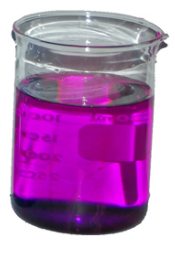Kalium (K) adalah suatu unsur kimia dalam tabel periodik yang memiliki lambang K dan nomor atom 19. Kalium berbentuk logam lunak berwarna putih keperakan dan termasuk golongan alkali tanah. Kalium teroksidasi dengan sangat cepat dengan udara, sangat reaktif terutama dalam air, dan secara kimiawi memiliki sifat yang mirip dengan natrium. Dalam bahasa Inggris, kalium disebut potassium.
Kalium bagi tanaman juga dapat berasal dari pupuk buatan (ZK); dan bahan pupuk kalium seperti: kalsium nitrat, gipsum, batuan posfat, super posfat, dan ca-cyanamide. Selain itu, sisa tanaman dan pupuk kandang juga dapat menjadi sumber kalium yang cukup penting.
Pada dasarnya Unsur Kalium (K) dalam tanah berasal dari: mineral-mineral yang terdiri dari primer tanah seperti: feldspar dalam bentuk KalSi3O8 (sumber utama) sebanyak 16 %, mika 5,2 % (terbagi dalam bentuk biotit ( (H,K)2(M,Fe)2Al2(SiO4)3) sebanyak 3,8 % dan muskovit (H2Kal3(SiO4)3) sebanyak 1,4 %); mineral sekunder: illit (hidrous mika), vermikulit, khlorit, dan mineral tipe campuran.
Dalam proses pertumbuhan tanaman, unsur K merupakan salah satu unsur hara makro primer yang diperlukan tanaman dalam jumlah banyak juga, selain unsur N dan P. Unsur K diserap tanaman dari dalam tanah dalam bentuk ion K+ dan banyak terkandung pada abu, seperti pada abu daun teh yang muda mengandung 50 % K2O, pucuk tebu muda mengandung 60 – 70 % K2O. Kandungan unsur K pada jaringan tanaman sekitar 0,5 - 6% dari berat kering. Bila tanaman sama sekali tidak diberi K, maka asimilasi akan terhenti. Ubi kayu, kentang, tebu nanas paling banyak memerlukan K2O di dalam tanah.
Kalium (K) merupakan unsur ketiga yang penting setelah N dan P. Kalium berfungsi antara lain untuk meningkatkan proses fotosintesis, mengefisienkan penggunaan air, mempertahankan turgor, membentuk batang yang lebih kuat, sebagai aktivator bermacam sistem enzim, dan meningkatkan ketahanan tanaman terhadap penyakit. Meskipun pada kenyataannya total K yang diserap oleh tanaman lebih besar daripada N maupun P, namun demikian perhatian mengenai kalium sampai saat ini masih kurang dibandingkan kedua unsur tersebut.
Fungsi kalium dalam fisiologi tanaman, selain untuk memperkuat batang dan perkembangan akar tanaman, juga sebagai transportasi glukosa dalam tanah yang menjadikan buah menjadi lebih manis (terbukti pada tanaman tebu dan buah buahan). Meningkatkan mutu buah dan bobot buah, dan ketahanan terhadap kekeringan. Aplikasi kalium yang optimum pada tanaman sawit akan meningkatkan produksi Tanda Buah Segar (TBS) dan meningkatkan rendeman. Pada tanaman perkebunan lainnya seperti coklat, tebu, singkong dan lada pemberian kalium terbukti meningkatkan hasil panen dengan kualitas yang tinggi.
Kekurangan kalium pada tanaman padi menyebabkan tanaman tumbuh kerdil dan daun-daun terkulai, penuaan daun lebih cepat (leaf senescence), kehampaan gabah tinggi dan pengisian gabah tidak sempurna (banyak butir hijau), pertumbuhan akar tidak sehat (banyak akar yang busuk karena kehilangan daya oksidasi, sehingga serapan hara terganggu), dan tanaman mudah terserang penyakit seperti blas, busuk batang, dan bercak daun.
Pada tanaman lainnya kekurangan kalium berdampak pada pertumbuhan batang yang lemah dan pendek-pendek sehingga menjadi kerdil, daun-daun tanaman mengerut atau keriting (tanaman kentang daunnya jadi menggulung), buah yang tumbuh menjadi tidak sempurna, kecil-kecil kuantitas dan kualitasnya rendah serta kurang tahan disimpan. Selain itu buah menjadi mudah gugur pada tanaman kelapa dan jeruk, tanaman menjadi lebih rentan diserang penyakit serta khusus tanaman umbi (hasil umbinya sangat minim dan kadar hidrat arangnya rendah).
Fungsi kalium bagi tanaman :
- Mempengaruhi susunan dan mengedarkan karbohidrat di dalam tanaman.
- Mempercepat metabolisme unsur nitrogen.
- Mencegah bunga dan buah agar tidak mudah gugur.
- Sebagai aktivator enzim. Sekitar 80 jenis enzim yang aktivasinya memerlukan unsur K.
- Membantu penyerapan air dan unsur hara dari tanah oleh tanaman.
- Membantu transportasi hasil asimilasi dari daun ke jaringan tanaman.
- Membantu pembentukan pati dan protein.
- Pembukaan stomata (mengatur pernapasan dan penguapan).
- Proses fisiologis dalam tanaman.
- Proses metabolik dalam sel.
- Mempertinggi daya tahan terhadap kekeringan dan penyakit selain itu juga berperan dalam perkembangan akar.
- Membantu mekanisme pengaturan osmotik di dalam sel
- Berpengaruh langsung terhadap tingkat semipermiabilitas membran dan fosforilasi di dalam khloroplast.
- Mengeraskan jerami dan bagian kayu dari tanaman, meningkatkan resistensi terhadap penyakit.
- Meningkatkan kualitas buah-buahan.
Dampak kekurangan unsur Kalium bagi tanaman:
- Tanaman yang kekurangan unsur hara Kalium akan menunjukkan gejala yang mirip dengan kekurangan unsur N.
- Pertumbuhan tanaman menjadi kerdil
- Seluruh tanaman berwarna pucat kekuningan (klorosis). Bedanya dengan kekurangan unsur N, gejala kekurangan unsur K dimulai dari pinggir helai daun sehingga terlihat seperti huruf V terbalik.
Pupuk KCl atau sering disebut MoP merupakan salah satu sumber kalium. Pupuk KCl (MOP/Muriate of Potash) SANMIN KCL adalah salah satu jenis pupuk tunggal yang mengandung unsur Kalium klorida (K2O) konsentrasi tinggi (99 %), berbentuk kristal berwarna putih. Sudah terbukti efikasinya dan sudah umum digunakan karena sangat efektif dan efisien dalam memacu pertumbuhan dan perkembangan tanaman dan dan dapat diaplikasikan pada semua jenis tanah.
SANMIN KCL tersedia Kemasan 25 kg/zak.
Michael
085894436642
michael@sanminglobe.com










